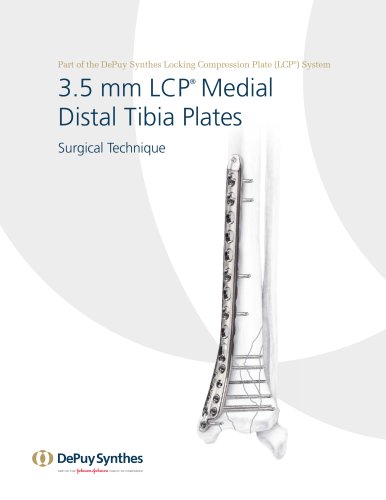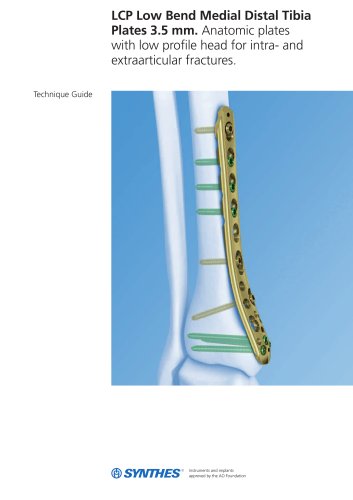 Website:
Depuy Synthes
Website:
Depuy Synthes
Group: Johnson & Johnson
Catalog excerpts

CONCORDE Interbody System ™ for Transforaminal Lumbar Interbody Fusion (TLIF) Surgical Technique
Open the catalog to page 1
Introduction CONCORDE™ Interbody System Surgical Technique Pedicle Screw Insertion 2 Facetectomy and Working Zone Preparation 3 Annulotomy and Initial Disc Dissection 5 Initial Distraction and Preparation of Disc Space 6 Final Disc Preparation and Endplate Cleaning 7 Decortication and Placement of Bone Graft 9 Cage Insertion—CONCORDE Interbody System 11 Implant orientation for lordotic CONCORDE 11 Interbody System Final Compression 12 Verification of Final Cage Placement 12 Product Information CONCORDE Interbody System Product catalog 14 CONCORDE Bullet Ti and CFRP Indications and Usage 20...
Open the catalog to page 3
Surgical Technique 1 Pedicle Screw Insertion Pedicle screws can be placed either before or after the interbody reconstruction. It is often advantageous to have screws as a distraction point during the procedure. Many surgeons place screws before the spinal canal is exposed. If placing screws is done after the facetectomy as shown (Figure 1), take extra care to avoid dural injury during the placement of guide wires, taps, or screws. Identify proper pedicle insertion points for guide wires, taps or screws. The optimal insertion point is at the intersection of the transverse process and...
Open the catalog to page 4
Surgical Technique 2 Facetectomy and Working Zone Preparation (L5/S1) In order to gain transforaminal access to the disc space, a unilateral facetectomy is performed. The side chosen for the approach is often determined by the location of the pathology or the presence of scar tissue. Resect the ligamentum flavum from the anterior surface of the lamina with a curette. The inferior lamina of L5 can be removed by a Kerrison rongeur illustrated by the dotted line of Figure 2 to improve access to the ligamentum flavum. Resect the inferior articular process of L5 with a straight osteotome or a...
Open the catalog to page 5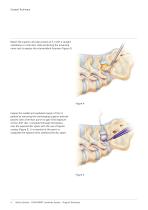
Surgical Technique Resect the superior articular process of S1 with a straight osteotome or a Kerrison while protecting the traversing nerve root to expose the intervertebral foramen (Figure 4). Expose the medial and cephalad margin of the S1 pedicle by removing the overhanging superior articular process with a Kerrison punch to gain final exposure of the L5/S1 disc. Complete thorough hemostasis over the exposed disc space with the use of bipolar cautery (Figure 5). It is essential at this point to coagulate the epidural veins overlying the disc space. 4 DePuy Synthes CONCORDE™...
Open the catalog to page 6
Surgical Technique 3 Annulotomy and Initial Disc Dissection Care should be taken to gently retract and protect the exiting L5 nerve root and lateral part of the central dural sac. A dissector or nerve root retractor is used to protect these structures at every step of the procedure (Figure 6). The epidural veins have now been ligated to afford a corridor of approach to the disc space. Perform a box annulotomy to create a window into the disc space (Figure 7). After the box annulotomy, a pituitary rongeur is used to initially remove loose nuclear tissue in order to clear an initial space for...
Open the catalog to page 7
Surgical Technique 4 Initial Distraction and Preparation of Disc Space Initial distraction of the disc space is necessary in order to access the disc for a thorough discectomy which is required for good fusion preparation and orientation for optimal cage insertion. Distraction can be achieved using one of the following methods: • Distraction between pedicle screws • Distraction between the spinous process Use of a starter dilator (8 mm) or a disc spreader from the disc preparation set as pictured in Figure 9. After the initial removal of disc tissue, a starter dilator (8 mm) or a spreader...
Open the catalog to page 8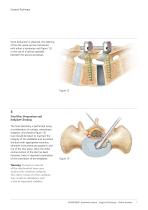
Surgical Technique Once distraction is obtained, the opening of the disc space can be maintained with either a temporary rod (Figure 12) or the use of a laminar spreader between the spinous processes. 5 Final Disc Preparation and Endplate Cleaning The final discetomy is performed using a combination of curettes, osteotomes, rongeurs, and shavers (Figure 13). Care should be taken to maintain the integrity of the endplates and to protect the dura with appropriate retractors wherever instruments are passed in and out of the disc space. Once the initial central portion of the disc has been...
Open the catalog to page 9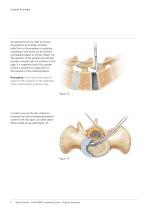
Surgical Technique An osteotome can be used to remove the posterior lip of either vertebral body flush to the endplates to optimize visualization and access for the anterior contralateral aspect of the disc (Figure 14). The resection of the posterior lip will also provide a smooth path for insertion of the cage. It is important that a flat, parallel surface is achieved in preparation for the insertion of the interbody device. Precaution: Care should be taken to preserve the integrity of the endplates when resecting the posterior lips. In order to ensure the disc material is removed from the...
Open the catalog to page 10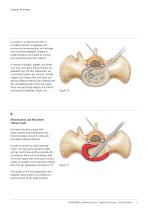
Surgical Technique A curette or a rasp can be used in a scraping fashion to separate and remove any remaining disc and cartilage from the bony endplates. Straight or angled rongeurs are utilized to remove any remaining loose disc material. A variety of straight, angled, and offset cup, ring, and down biting curettes are available from the disc preparation set to facilitate further disc removal. Double angled cup curettes (left and right) can also be utilized to remove disc material from the contralateral side of the disc space; these will specifically address the inferior and superior...
Open the catalog to page 11
Surgical Technique 7 Cage Trialing Trialing to aid in correct selection of the implant is extremely important. A cage trial should be used prior to insertion of the implant to evaluate potential cage placement and determine the optimal implant fit (Figure 18). Lateral fluoroscopy may be useful in analyzing implant orientation and ultimate desired lordosis. The cage trials match the parallel configuration available with CONCORDE Interbody System Implants. Trials are sized to match the overall height of the corresponding implant, including the teeth of the implant. 11 DePuy Synthes ...
Open the catalog to page 12All Depuy Synthes catalogs and technical brochures
-
ZERO-P NATURAL™PLATE
5 Pages
-
2.0 mm LCP® Distal Ulna Plate
20 Pages
-
SYNFLATE SYSTEM
3 Pages
-
2.4 mm VA LCP™
4 Pages
-
Building on Success
16 Pages
-
HEALIX ADVANCE
4 Pages
-
RADIUS OF CURVATURE
3 Pages
-
Introducing The Variable Angle
12 Pages
-
HEALIX Anchor™ 3.4 mm
2 Pages
-
Small Battery Drive II
4 Pages
-
HEALIX ADVANCE
4 Pages
-
3.5 mm LCP™ Medial
15 Pages
-
Titanium Sternal Fixation System
34 Pages
-
MatrixRIB®FixationSystem
86 Pages
-
Mandible Trauma Solutions
2 Pages
-
Power line II
4 Pages
-
LCP Intercarpal
31 Pages
-
LCS® COMPLETE™
2 Pages
-
Synthes TPLO.
8 Pages
-
SynFix-LR System
56 Pages
-
ATB Anterior Tension Band Plate
32 Pages
-
CONDUIT™
15 Pages
-
Brochure_FINAL
2 Pages
-
DePuy Synthes
81 Pages
-
Anspach
3 Pages
-
Orthopedic Foot Instruments
32 Pages
-
PINNACLE® Hip Solutions
12 Pages
-
Corail
24 Pages
-
S-ROM® NOILES™
68 Pages
-
TRI-LOCK® Product Rationale
12 Pages
-
Reclaim Surgical Technique
44 Pages
-
Speed
2 Pages
-
attune
80 Pages
-
HAMMERLOCK® 2
2 Pages
-
DePuy Glenoid Solutions
2 Pages
-
Trauma Solutions. Elbow
4 Pages
-
Polar
4 Pages
-
Alveolar Distractor.
4 Pages
-
Piezoelectric System
4 Pages
-
Air Power Line II
6 Pages
-
LCP Clavicle Hook Plate
4 Pages
-
TruMatch Pin Guides
16 Pages
-
P F N A
8 Pages
-
SKILL, DEDICATION,
16 Pages
-
Orthopaedics. Overview
20 Pages
-
DURALOC
16 Pages
-
Marathon Cemented Cup
20 Pages
-
REEF Surgical Technique
16 Pages
-
MatrixNEURO
8 Pages
-
Anspach XMax
4 Pages
-
Anspach eMax 2 Plus
4 Pages
-
Small Electric Drive
4 Pages
-
Air Pen Drive
4 Pages
-
Colibri II
4 Pages
-
Spine
25 Pages
-
Expert Hindfoot Arthrodesis Nail
48 Pages
-
LCP Distal Fibula Plates
32 Pages
-
TomoFix
60 Pages
-
Expert Tibial Nail PROtect
16 Pages
-
Expert Tibia Nail
84 Pages
-
Sacral Bars
16 Pages
-
Pelvic C-Clamp
20 Pages
-
Low Profile Pelvic System
16 Pages
-
Proximal Femoral (Hook) Plate
24 Pages
-
LCP
24 Pages
-
PFNA
112 Pages
-
HCS 1.5, 2.4, 3.0
36 Pages
-
LCP Wrist Fusion
32 Pages
-
LCP Compact Hand
28 Pages
-
VA-LCP Elbow
48 Pages
-
Distal Radius
44 Pages
-
Olecranon
30 Pages
-
LCP Hook Plate
28 Pages
-
DHP & Olecranon
4 Pages
-
LCP S-A
4 Pages
-
Epoca
4 Pages
-
Philos
32 Pages
-
MultiLoc
68 Pages














